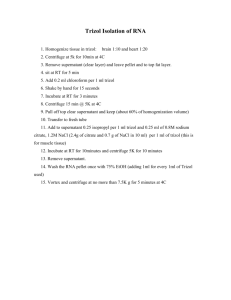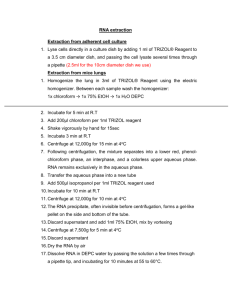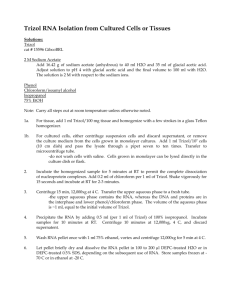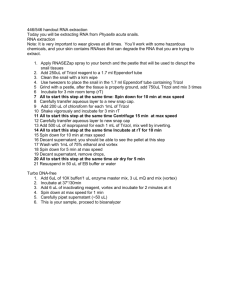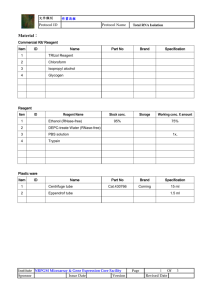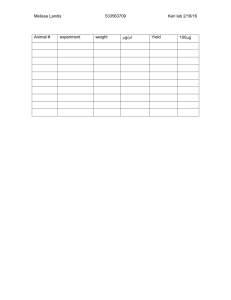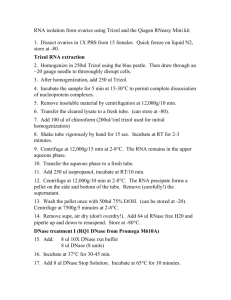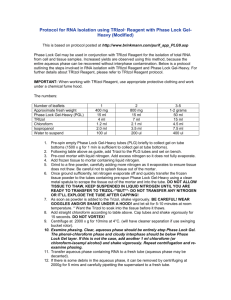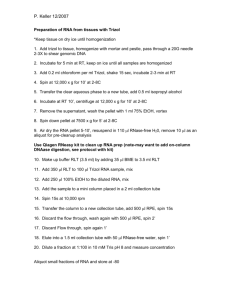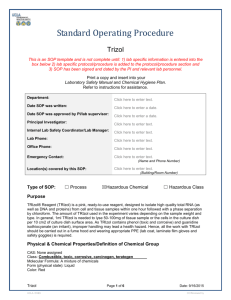SOP on RNA extraction from HCC tissue
advertisement
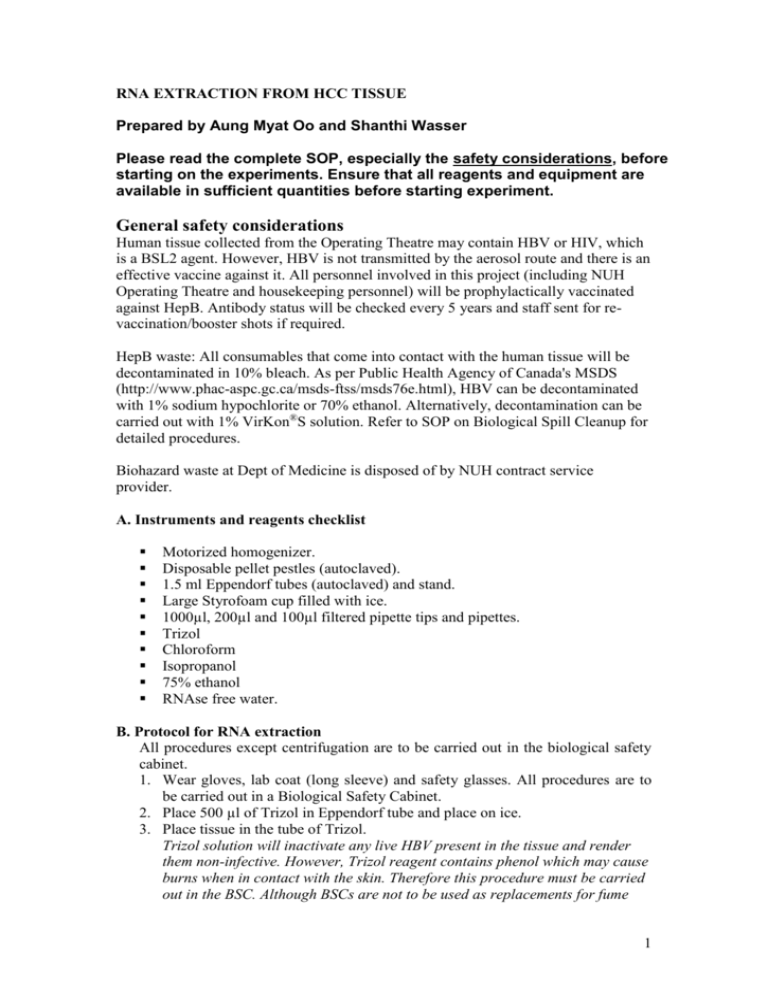
RNA EXTRACTION FROM HCC TISSUE Prepared by Aung Myat Oo and Shanthi Wasser Please read the complete SOP, especially the safety considerations, before starting on the experiments. Ensure that all reagents and equipment are available in sufficient quantities before starting experiment. General safety considerations Human tissue collected from the Operating Theatre may contain HBV or HIV, which is a BSL2 agent. However, HBV is not transmitted by the aerosol route and there is an effective vaccine against it. All personnel involved in this project (including NUH Operating Theatre and housekeeping personnel) will be prophylactically vaccinated against HepB. Antibody status will be checked every 5 years and staff sent for revaccination/booster shots if required. HepB waste: All consumables that come into contact with the human tissue will be decontaminated in 10% bleach. As per Public Health Agency of Canada's MSDS (http://www.phac-aspc.gc.ca/msds-ftss/msds76e.html), HBV can be decontaminated with 1% sodium hypochlorite or 70% ethanol. Alternatively, decontamination can be carried out with 1% VirKon®S solution. Refer to SOP on Biological Spill Cleanup for detailed procedures. Biohazard waste at Dept of Medicine is disposed of by NUH contract service provider. A. Instruments and reagents checklist Motorized homogenizer. Disposable pellet pestles (autoclaved). 1.5 ml Eppendorf tubes (autoclaved) and stand. Large Styrofoam cup filled with ice. 1000µl, 200µl and 100µl filtered pipette tips and pipettes. Trizol Chloroform Isopropanol 75% ethanol RNAse free water. B. Protocol for RNA extraction All procedures except centrifugation are to be carried out in the biological safety cabinet. 1. Wear gloves, lab coat (long sleeve) and safety glasses. All procedures are to be carried out in a Biological Safety Cabinet. 2. Place 500 µl of Trizol in Eppendorf tube and place on ice. 3. Place tissue in the tube of Trizol. Trizol solution will inactivate any live HBV present in the tissue and render them non-infective. However, Trizol reagent contains phenol which may cause burns when in contact with the skin. Therefore this procedure must be carried out in the BSC. Although BSCs are not to be used as replacements for fume 1 cupboards, the use of the small amounts of Trizol required in this procedure will not damage the HEPA filter of the BSC. Please refer to Trizol MSDS (on file in the lab) for action to be taken in case of accidental spills/splash of Trizol. ( NB: PEG required to “clean up” accidental splashes on the skin is available in the lab chemical shelf). 4. Homogenize tissue with tube in ice using the motorized homogenizer. This process must be carried out in the BSC cabinet to minimize dispersal of aerosols that are formed during the process. 5. After homogenization, add another 500 µl of Trizol. 6. Incubate for 5 min at room temperature. 7. Add 200 µl of chloroform and shake tube by for 15 seconds 8. Incubate at room temperature for 3 minutes. 9. Centrifuge at 12,000 g for 15 min at 2-8 degree C. 10. Remove the upper layer and place in new tube. 11. Add 500 µl of isopropanol and incubate at room temp for 10 min. 12. Centrifuge at 12,000 g for 10 min at 2-8 degree C. 13. Remove the supernatant (leave the pellet alone). 14. Add 1 ml of ethanol. 15. Vortex (making sure that the tubes are securely capped to prevent accidental spills) and centrifuge at 7500 g for 5 min at 2-8 degree C. 16. Remove supernatant and air dry the RNA pellets for 10 min. 17. Dissolved in 50-100 µl of RNAse free water and store at -80 freezer. SAFETY MEASURE: Before preparation procedure, wear gloves, lab coat (long sleeve) and eye protective gear (safety glasses). All processes of tissue cutting and processing procedures are to be carried out in the biological safety cabinet. All materials in contact with or contaminated with tissue were disposed of into designated biohazard containers. All equipment and work surfaces were disinfected after use with freshly diluted 10% bleach solution or 1% VirKon solution. Accidental cut or stab with items contaminated with blood: Wash the wound with soap and running water immediately and continue for at least 10 minutes. Squeeze or scrub the wound to induce bleeding if possible. Report and get medical assistance. For eye exposures, flush eyes under eyewash for at least 10 minutes. Report and get medical assistance. 2
